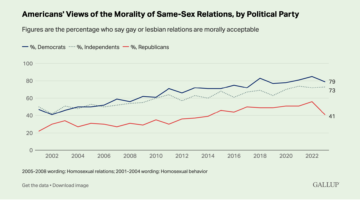Intersex Awareness Day: Debunking Common Intersex Myths
October 26, 2023 by Merissa Prine
October 26th is Intersex Awareness Day. In a world that is becoming increasingly inclusive and accepting of various sexual and gender minorities, intersex awareness remains an important, yet often overlooked, part of the broader conversation. So let’s take a moment to debunk some of the all-too-common myths associated with being intersex.
Intersex Awareness Day traces its roots to 1996 when members of the Intersex Society of North America and their supporters gathered in Boston, Massachusetts during the annual American Academy of Pediatrics conference [1]. They demanded that the medical community acknowledge the unnecessary and often harmful genital surgeries that were being routinely imposed on intersex infants. Through their protest and public display of their lived experiences, these individuals helped pave the way for more acknowledgement, dignity, and respect of intersex people. This day is meant to acknowledge their efforts and continue toward greater intersex awareness.
What Does Intersex Mean?
What does the term intersex actually mean? Intersex is an umbrella term that describes people with sex characteristics that do not fit typical binary understandings of male and female bodies [2]. Some intersex people have external genitals and/or internal sex organs that are different from the traditional male/female binary. Intersex people may also have unique combinations of sex chromosomes like XXY or some cells that are XX and others that are XY [2,3]. For some people, it may be obvious that they are intersex from birth, whereas others might only become aware during their adolescent years or, in some cases, may remain unaware throughout their lives [1].
For much of our history, our external genitalia have been the sole marker for where we fit into the sex binary. However, as science has progressed, we have discovered that these “distinct” categories are not quite as distinct as previously assumed (see our blog: It’s A Fuzzy Line Between Male And Female).
Intersex persons (whether they are known to be intersex or not) are typically assigned a sex (i.e., male or female) at birth; however, this assignment is not always consistent with their subsequent gender identity [2]. Intersex individuals can potentially align with any gender identity (such as man, woman, non-conforming, etc.) and sexual orientation. Further, not all intersex individuals necessarily identify with the LGBTQ+ community.
Misconceptions and Stigma
There are a variety of harmful misconceptions associated with being intersex. We will address some of these myths below and provide evidence-based information to help combat them:
MYTH: Intersexuality is vanishingly rare.
FACT: It is important to recognize that intersex people are more common than one might realize. Approximately 2% of people born in the USA are intersex, and there are many different ways that someone can be intersex [2]. Whether you realize it or not, it is likely that you know someone who is intersex.
MYTH: Being intersex is a medical condition that needs to be “fixed.”
FACT: Being intersex is naturally occurring in humans and does not inherently require medical intervention [2]. Historically, many intersex infants and children have undergone purely cosmetic and often unnecessary medical procedures to “normalize” their bodies at the direction of parents and doctors. These interventions can have long-lasting physical and psychological consequences. Many have claimed that these procedures are a direct violation of human rights [4] because these surgeries were not the choice of the individual, they are irreversible, and they sometimes lead to medical complications or other problems (e.g., loss of sexual sensation or function).
Today, there’s growing recognition of the need for informed consent and bodily autonomy for intersex individuals. Intersex persons should have a say in what happens to their own bodies and shouldn’t be subjected to genital-altering surgeries and other treatments that are not medically necessary.
MYTH: Being intersex is “unnatural” or “disordered.”
FACT: People often assume that it is “natural” to be born either male or female, with any deviations from this seen as unnatural. However, being intersex is simply a variation of human biology. And in biology, variation is the rule, not the exception. This is why some argue that sex is better conceptualized as a spectrum [5]. For example, almost every sex characteristic has variable properties (e.g., any given genital structure varies considerably in size, shape, and appearance). Author Emily Nagoski expressed it well in saying that we’re all made from the same parts, just organized in different ways.
Importance of Intersex Awareness
Supporting intersex people is important for promoting inclusivity, putting a stop to potentially harmful and unnecessary medical practices, fostering empathy, and advocating for human rights. Intersex awareness is an essential component of our ongoing journey toward a more inclusive, understanding, and accepting society. By dispelling myths, increasing public education, and supporting intersex individuals and their rights, we can contribute to a world in which every individual is respected and valued for their uniqueness.
Ways to Support and Advocate for Intersex People
You may be wondering how you can advocate for intersex people. You can do your part by sharing informational content (like this blog), educating yourself and others about what it means to be intersex, listening to intersex voices, challenging myths and stereotypes, and by supporting intersex organizations.
For another perspective on the importance of intersex awareness, check out Steph’s story:
References
[1]: Intersex Awareness Day history and social media resources. interACT. https://interactadvocates.org/intersex-awareness-day/
[2]: What is intersex?: Definition of intersexual. Planned Parenthood. https://www.plannedparenthood.org/learn/gender-identity/sex-gender-identity/whats-intersex
[3]: Intersex: What is intersex, Gender Identity, intersex surgery. Cleveland Clinic. https://my.clevelandclinic.org/health/articles/16324-intersex
[4]: Bauer, M., Truffer, D., & Crocetti, D. (2020). Intersex human rights. The International Journal of Human Rights, 24(6), 724–749. https://doi.org/10.1080/13642987.2019.1671354
[5]: Štrkalj, G., & Pather, N. (2021). Beyond the sex binary: Toward the inclusive anatomical sciences education. Anatomical Sciences Education, 14(4), 513–518. https://doi.org/10.1002/ase.2002
Want to learn more about Sex and Psychology? Click here for more from the blog or here to listen to the podcast. Follow Sex and Psychology on Facebook, Twitter (@JustinLehmiller), or Reddit to receive updates. You can also follow Dr. Lehmiller on YouTube and Instagram.
Image credits: Tim Mossholder via Unsplash

Dr. Justin Lehmiller
Founder & Owner of Sex and PsychologyDr. Justin Lehmiller is a social psychologist and Research Fellow at The Kinsey Institute. He runs the Sex and Psychology blog and podcast and is author of the popular book Tell Me What You Want. Dr. Lehmiller is an award-winning educator, and a prolific researcher who has published more than 50 academic works.
Read full bio >


